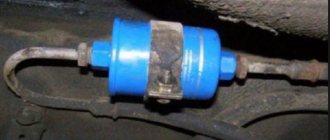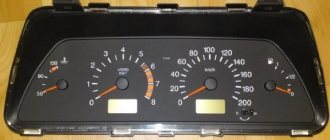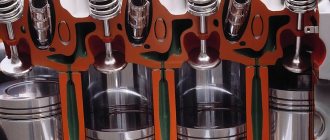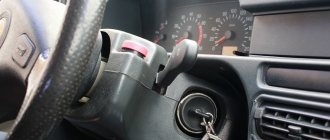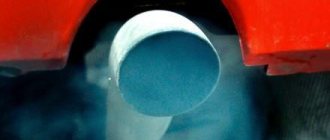Sometimes from a car service technician, or just car lovers, you can hear the phrase “The engine is bad.” This expression means that one or two of the engine cylinders have failed. If the VAZ 2114 engine has problems with the 8-valve injector, then most likely the reason is a breakdown of the fuel injection system. Although other options are possible.
VAZ 2114 engine
How can you tell if the engine is leaking?
Signs that the VAZ 2114 engine is malfunctioning:
- jerks when driving or accelerating a car - the car does not develop the necessary power;
- increase in fuel consumption - due to malfunction of the injection system;
- uneven exhaust - you can hear popping noises and smell unburnt gasoline;
- vibrating, uneven sound of the engine - due to malfunction of the valves and all rotating parts of the engine;
- feeling of vibration and “shaking” at idle.
The origin of the phrase dates back to the days of four-cylinder engines. If one of the cylinders failed, three remained operational. Now the engine design has changed, but the common expression remains.
Troubles the VAZ 2114 engine
If it starts and then stalls
Many car enthusiasts have encountered this problem more than once. The search for possible causes and malfunctions begins. The ECU is tested, everything possible is checked, but the result is zero. The engine still sputters and stalls.
In this case, you can check the condition of the injectors. For many, after serious diagnostics, this problem was very easily, simply and inexpensively solved by cleaning the injectors and fuel rail.
Main reasons
The following reasons can lead to such a breakdown:
- low level of compression in the cylinders (for example, due to poor valve fit);
- injector contamination - the injection system is disrupted as a result of poor flow or fuel overflow;
- lack of spark supply to the spark plug - due to a malfunction of the spark plug or high-voltage wire;
- air filter contamination;
- control unit failure;
- malfunction of the crankshaft position sensor;
- change in position, or initial incorrect installation of the timing belt.
Failure of one cylinder can lead to breakdown of the entire engine. The gasoline that enters the idle cylinder does not burn out and mixes with the oil. As a result, the oil loses its properties and engine parts begin to wear out.
Engine operating principle
Troit in wet weather
Yes, and this is not a joke. Many owners who have VAZ cars note that recently washed or just on a damp day, “iron horses” begin to trip.
Common causes include fluid that has gotten into the spark plug wells.
As a result, the spark plug stops sparking, which means the cylinder cannot work correctly. But that's not all.
Thus, various sensors could fail due to exposure to an aggressive environment. Also, when washing with high pressure washers, various vulnerable parts could be damaged.
As for environmental conditions, in wet weather the engine stalls after a long period of inactivity. The engine does not start immediately, but after the fifth or sixth time. The engine runs rough and unstable until it warms up completely. Visual inspection often does not give results. Engine operation becomes normal after some time until it cools down completely or until the next rain. The reason here is partly the same as after a car wash.
Dampness, or more precisely, condensation accumulates under the distributor body. There is an easy way to diagnose this problem. Start the engine in the dark. If you see lights under your hood, you need to replace the wires.
Don't forget about candles. If the engine does not want to start in damp conditions, then most likely the spark plugs need to be replaced. They may have stopped producing a strong spark. On a wet, rainy day, moisture can accumulate on the candles, which leads to current leakage. Ignition coils are also often to blame. Their bodies crack, and condensation accumulates in them.
How to find out the exact cause of the breakdown?
To determine why the VAZ 2114 engine is tripping, you need to:
- Detect a dead cylinder:
- start the engine and gain access to it by lifting the hood;
- remember the sound of a running engine;
- remove the wires from each cylinder one by one;
- If the sound of the working cylinder changes when you remove the wire, it means it is working. In the event of a malfunction, the character and rhythm of the sound does not change even after the power is turned off.
- Find out if a spark is getting to the cylinder:
- remove the spark plug using a special key;
- clean it from carbon deposits and soot. Sometimes simple cleaning helps, but this is only a temporary measure;
- check the integrity of the electrode. High voltage wires can be checked using a conventional multimeter;
- check for spark supply to the spark plug. To do this, you need an assistant to start the starter. The spark plug with the high-voltage wire must be attached with the metal part to the engine. If a spark does not appear when the starter bendix rotates, then the spark plug is faulty.
Soot on candles - If the reason is not the ignition, then you need to check:
- dirty injectors;
- valve adjustment;
- tight fit of valves to seats;
- compression level in the cylinder, and other possible reasons related to the fuel injection system.
Checking the injectors of the VAZ 2114
Poor quality fuel - sand or rust in gasoline can cause contamination of the injectors. Engines with injection type are very demanding on the quality of gasoline. Therefore, if there are problems with the engine, it is recommended to drain the fuel and use another one.
The engine stalls when cold
There are situations when the engine only stalls at idle speed. If a VAZ 2114 stalls when cold, most often the reason is a large gap between the valve and its rocker (“rocker arm”). After the engine warms up, the distance decreases and the cylinder operation stabilizes.
Other reasons are also possible:
- A “rich” or “enriched” fuel mixture is supplied due to a malfunction of the control unit.
- There is moisture on the wires or ignition coil.
- The spark plug does not work until the engine warms up.
- The piston group is worn out.
- The valve is deformed due to water hammer.
Troubling when the engine is warm
If problems with operation are observed only when the engine is warm, then the probable causes are:
- Damage to the engine control unit.
- The ignition coil sparks (pierces).
- The cylinder head gasket is worn.
Engine control unit for VAZ 2114
Tips for motorists
The VAZ-2114 passenger car (Samara-2) was discontinued last year, 2013. It was equipped with five injection engines, three of which (2111, 21114, 11183) had an eight-valve gas distribution mechanism (GDM), and two (21124, 21126) had a sixteen-valve timing mechanism.
Most often, drivers begin to notice that interruptions in engine operation appear at idle. Moreover, immediately after starting a cold engine, interruptions are not heard, but as soon as the engine warms up, it begins to “twitch” (twitch), and the Check Engine sign lights up on the instrument panel, requiring a diagnostic check of the engine. It is advisable to carry out diagnostics, since searching for a fault blindly may take a long time and be unsuccessful.
But it must be remembered that a possible cause of engine twitching at idle may be unadjusted timing valves, the thermal clearance of which must be checked every 20 thousand kilometers. There are cases that even on a new engine one of the valves turns out to be “pinched”, and the thermal gap will only be there while the engine is cold, but as soon as it warms up, the valve opens slightly and the engine begins to operate unstably at idle.
A possible reason for the intermittent operation of the engines (2111, 21114, 11183) of the VAZ-2114 car may be a malfunction of one of the spark plugs, poor contact of the high-voltage wire or its breakdown to ground. For engines (21124, 21126), failure of the spark plug or ignition coil. Malfunctions of spark plugs include the appearance of black carbon deposits on the insulator, as well as a large increase in the gap between the central and side electrodes.
Unstable operation of the engine can be caused by air leaks that enter the engine cylinders, bypassing the throttle assembly, which causes a lean mixture and a sharp decrease in crankshaft speed. Air leaks into the cylinders are possible due to a malfunction of the vacuum brake booster valve located in the flange to which the hose leading to the intake manifold is connected.
The injectors may also be involved in the same malfunction if the nozzle holes are completely or partially coked or, due to poor contact in its block, it does not fire every time. There may also be insufficient pressure in the fuel rail, which the fuel pump cannot create due to a clogged fuel filter or contamination of its intake chamber, the entrance to which is blocked by a fine mesh.
How to fix the problem?
After the reasons why the VAZ 2114 engine is tripping have been determined , it is necessary to act depending on the situation:
- If there are problems in the ignition system, replace the broken spark plug or high-voltage wires.
- If the reason is in the fuel injection system or compression level, clean the injectors with ultrasound, adjust or replace the valves, air filter, check the position of the timing belt.
If these actions do not lead to results, you need to check and, if necessary, replace:
- Control block;
- crankshaft position sensor;
- oxygen sensor.
Thus, engine tripping is a common breakdown that, with experience and skillful hands, can be corrected on your own. If the cause of the tripping is a breakdown in key systems (control units) or there is no special equipment at home (for example, for cleaning injectors with ultrasound), it is recommended to contact a service station.
VAZ 2114 ENGINE CHARACTERISTICS
The VAZ 2114 car is mainly equipped with an 8-valve 4-cylinder engine, the fuel system and ignition are controlled by an electronic unit (ECU). The electronics have many different sensors that inform the unit about the condition of the engine. The control unit, in turn, reads the necessary information and gives commands to those devices that directly affect the operation:
- Distributes the spark among the cylinders in a certain order;
- Determines the required amount of supplied fuel (leans or enriches the fuel mixture depending on the number of revolutions).
The electronic control system of the VAZ 2114 contains the following sensors:
- Crankshaft position sensor (CPS);
- Camshaft position sensor or phase sensor (DPRV);
- Idle air regulator (or sensor) (IAC);
- Throttle position sensor (TPS);
- Knock sensor (DS);
- Air flow sensor or flow meter (AFM);
- Lambda probe or oxygen sensor.
Failure of any of these sensors leads to unstable engine operation, and if the DPKV fails, the car most likely will not start at all. Fuel is supplied to each cylinder using an electronically controlled injector. A faulty injector can also cause poor engine performance.
conclusions
It is important to very carefully monitor the condition of the car and its individual components. With good care and timely replacement of consumables and fluids, this machine will work no worse than a Swiss watch. Well, if suddenly the unit completely fails, you can always purchase and install a new one - the price of a 1.6-liter engine is about 20 thousand rubles.
So, we have found out the main reasons why one of the cylinders in a VAZ-2114 car may not work.
Source
Cylinder failure: causes and diagnostic methods
Issues discussed in the material:
- Why does cylinder failure occur in an engine?
- What is the danger of cylinder failure?
- How to independently identify the cause of cylinder failure
While driving a car, did you feel that the power unit was vibrating, while its power dropped, and it began to consume more fuel? Does the car start only the second or third time? These signs indicate that a cylinder failure has occurred. In our article today we will look at how to fix this problem.
What to do?
There are a number of measures that are recommended to be taken when it is discovered that the engine is tripping. All of them will allow you to answer certain questions. Therefore, get ready to devote a lot of time to your car.
The first thing you need to do is identify the failed cylinder. He's not alone there. To do this you need:
- Open the hood while starting the engine;
- Listen and remember the sound your engine is making now;
- Remove the wires from the spark plugs one by one. If you remove the high voltage wire, the sound should change. If, when removing the next high-voltage cylinder, the sound does not change, congratulations, you have found the faulty cylinder.
Now we dismantle the problematic spark plug and check it for functionality. To do this, you will need a special wrench designed specifically for removing spark plugs:
- Pay attention to the electrode. If it is clean and intact, but there is a lot of burning on the head, most likely there is a large amount of dust in the combustion chamber. This indicates a malfunction of the air filter in the air supply system;
- If soot is present on the head and the electrode, which is noticeably burnt out, the mixture is poor, combustion occurs with premature ignition;
- If the head is burnt, but the electrode is intact, the mixture was rich and the ignition was delayed;
- Check for spark. If it is, then the problem needs to be looked for further. When there is no spark, it is recommended to replace it with a new one and check the performance of the engine with a new spark plug.
If your car has quite an impressive mileage, it is recommended to perform the following operations to identify the causes of the “triple”:
- Replace spark plugs;
- Dismantle the old high-fibers and replace them with new, high-quality ones. Sometimes banal microcracks on them lead to breakdowns and failure of the entire power unit;
- Measure the compression in the cylinder that is not firing. When detecting violations, you may determine that the valves are burnt out or the problem is in the rings;
- Perform valve adjustments. In general, a similar procedure is carried out at intervals of 15-20 thousand kilometers for the purpose of prevention;
- Check if the ignition coil is working. A common problem for the VAZ 2114. There is no point in trying to repair it; it is better to immediately replace it with a new one. It won't cost you a fortune;
- Replace the old air filter with a new similar unit;
- Check that the timing belt is installed and functioning correctly.
Even if these measures did not produce any results, we advise you to try a few more effective methods for restoring engine performance:
- Check the operation of the electronic control unit. If problems are detected, immediately replace the old electronic control unit with a new one;
- Check the functionality of the fuel supply system. In some cases you will have to get all the way to the injectors;
- Analyze the operation of the oxygen sensor. It can be repaired, but it would be better to replace the device immediately;
- Make sure the crankshaft position sensor is working properly. This is determined using an electronic control unit. It will display an error indicating that there is a problem. If there are problems with the sensor, there is nothing else to do but replace it with a new one.
Problems at idle
This is a particularly common situation. And it makes no difference at all whether the engine is cold or warm. In this case, there are very, very many reasons. It could be something as simple as a failure of one of the spark plugs to serious problems in the piston group. If the part is easy to change, then worn cylinders require serious repairs. VAZ-2114 is no exception.
Thus, unstable operation of power units at idle speed may be due to clamped valves, mismatched timing belt marks, or burnt-out valves in the engine. They can also be damaged due to water hammer. Various malfunctions in the electronics are also possible.
Unstable engine operation
Unstable engine operation when cold can create discomfort, which many people fix for money at a car service center. But, this malfunction can be fixed in your garage, with a minimum set of tools.
This engine trembles when starting
Of course, novice motorists first need to study the structure of the VAZ-2114 engine.
Main reasons
So, first we need to consider what could be the reasons why the engine started to misfire when cold:
- Problems with spark plugs.
- Malfunction of high-voltage wires.
- Malfunction of the mass air flow sensor (see “checking the mass air flow sensor on the VAZ-2114”).
- Fuel system malfunction.
- Valve clearances.
- Air filter.
- ECU.
Elimination methods
Now that the main causes have been identified, you can proceed directly to identifying the specific cause and the elimination method that will lead to normalization of the operation of the main power unit. So, let's consider the sequence of actions aimed at eliminating the causes of the effect.
Spark plug
Dirty spark plugs
The first and, perhaps, the most common reason that the engine begins to stall was and remains spark plugs (see “choosing spark plugs for the VAZ-2114”).
Accumulated carbon deposits or breakdown of an element may cause the fuel mixture to stop igniting in one of the cylinders. To fix the problem, you need to carry out a number of operations:
- Remove the terminal from the battery.
- We remove the high-voltage wires from the spark plugs.
- Using a spark plug wrench, we remove the spark plug sequentially from each cylinder.
- We carry out diagnostics, namely inspecting the element, as well as measuring gaps and resistance.
When a non-working spark plug is found, it must be replaced with a new one, having previously adjusted the gaps, and also checked for resistance. This is due to the fact that even from the manufacturer’s factory you can receive a defective part . Now, we install a new element and put everything back to its original form. Next, you need to check whether the negative effect has disappeared.
High voltage wires
High voltage wires are marked with arrows
High-voltage wires are another common cause of unstable engine operation. Moreover, this effect will be visible not only when cold, but also at speed. Diagnostic operations are carried out quite easily:
- We remove the wires from the spark plugs and ignition coils.
- We take measurements using a tester or an oscilloscope (if available).
If the measurement shows that one of the wires has failed, or there is a visual violation of the insulation, it must be replaced with a new one.
As practice shows and the manufacturer recommends, it is best to replace high-voltage wires as a set so that the engine can operate without any changes.
Air filter
Part of the air filter replacement process
Compression measurement
Then we measure the compression.
1) Turn off the ignition
2) Remove the spark plug
3) Screw in the compression gauge
4) We are looking for a partner who will start the car
5) We start turning the engine and look at the compression
Warning: under no circumstances allow the end of the high-voltage wire to touch you or the car body when igniting.
The norm for compression is 14 atmospheres. A deviation of 3 atmospheres is permissible, that is, from 11 atmospheres, this will be the norm for cylinders.




